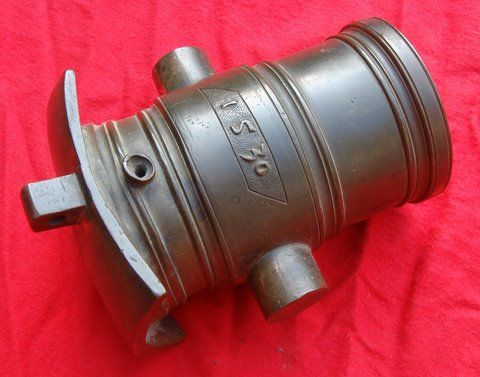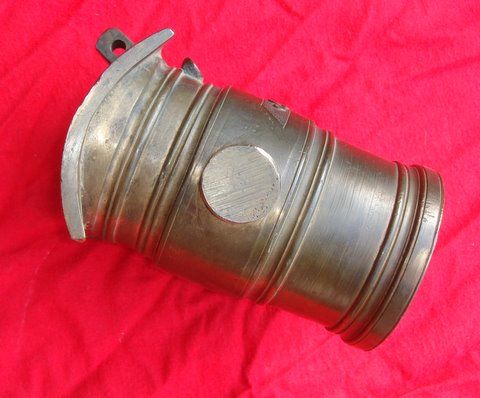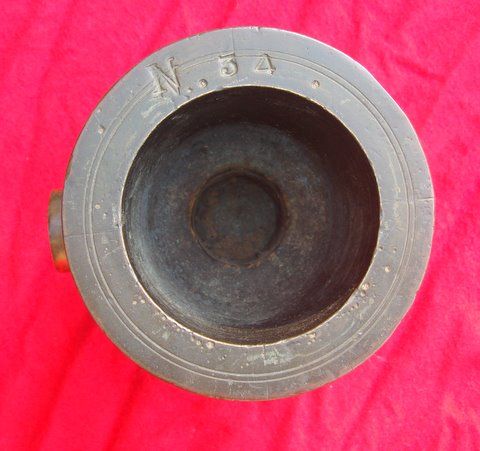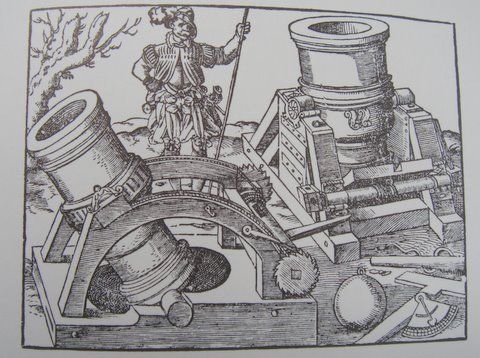
 |
|
|
#1 |
|
Member
Join Date: Jun 2006
Posts: 161
|
This mortar barrel model is marked "1530." It is bronze. Bore is two inches, total length is nearly eight inches. It belongs to a friend who has asked a few questions:
1. What nationality is this piece? 2. Was it cast in 1530? 3. What was the purpose of this model? He provided the engraving shown, without whatever caption it may have had. You can see that the large mortar on the right has a similar barrel with "rocker" base and protruding stud whereby the mortar is elevated with a winch.     
|
|
|

|
|
|
#2 |
|
(deceased)
Join Date: Sep 2008
Location: Bavaria, Germany - the center of 15th and 16th century gunmaking
Posts: 4,310
|
Hi John,
This a very unusual item indeed and rare to find in any museum! As the date 1530 is cast and chiseled in high relief against a dotted ground, and the cyphers are of correct Early Renaisance form, it must have been cast together with the mortar. The no. 54 stamped at the muzzle is certainly of later date, probably 17th or 18th c. The rocker base is rarely to be found but not totally unknown. The most renowned centers of bronze cannon casting at that time were Innsbruck/The Tyrol, as well as Nuremberg and Augsburg in South Germany. I am quite sure that his was just a workshop model for display and to acquire orders and then cast the real thing in much larger scale. Best, Michael Last edited by Matchlock; 21st January 2012 at 10:59 PM. |
|
|

|
|
|
#3 |
|
(deceased)
Join Date: Sep 2008
Location: Bavaria, Germany - the center of 15th and 16th century gunmaking
Posts: 4,310
|
I attach an image of the same date, 1530, on the barrel of the earliest known dated wheellock arquebus, by the Ausburg gunsmith Bartholomäus Marquardt, who worked for the Roman Emperor Charles V.
Real Armería Madrid, inv.no. K 23. m |
|
|

|
|
|
#4 |
|
Member
Join Date: Jun 2006
Posts: 161
|
Michael, thanks. I interpret your reply to mean that you think this piece was actually made in 1530, so if you have any doubt, please let me know.
I liked the casting and turning on it, and like you, the "1530" looked "period." However what bothered me was the rather thin and not-very-dark patina on the bronze. The piece does not look like it has been polished or at least not polished much, because the fine lines from turning and scribe marks on the muzzle are still sharply-defined. Therefore, I was a bit surprised that there is still any bronze on the piece that is somewhat shiny or with little patina. 1. Have you seen other examples of 16th C. bronze with such a thin/light patina? 2. I predict my friend will want to know if you considered the possibility that this could have been cast somewhere other than in Germany or Austria. For example Baude and Owen were casting very fine pieces in England at about that time. Last edited by cannonmn; 22nd January 2012 at 12:47 AM. |
|
|

|
|
|
#5 |
|
(deceased)
Join Date: Sep 2008
Location: Bavaria, Germany - the center of 15th and 16th century gunmaking
Posts: 4,310
|
Hi John,
There is always a certain possibility that pieces that look 'as new' are newly made and that that of your friend has been cast after a 1530 original. In order to tell one from the other a close examination would be necessary, including filing a small portion off the metal and having it spectro-analyzed in a laboratory. Original early-16th c. bronze or brass pieces contained a relatively high percentage of copper and silver, so even if overcleaned they mostly look a bit reddish. As to the terminology of brass or bronze barrels, museum, auction houses and collectors alike tend to just label them 'bronze' as it sounds higher-value. We should, as always, go back the roots and confer the old terms. In 500 year old books and armory inventories, e.g. the Maximilianische Zeugbücher illustrated by Jörg Kölderer of Innsbruck/The Tyrol, where the Maximilian main armory was located, we never find the term bronze, just Messing (brass) or Kupfer (copper). Of course the difference between the two alloys is mostly a higher amount of copper in bronze. Yes, I did see a few totally overcleaned pieces with even the tiniest spot of patina removed, and of course they looked 'as new'. What really bothers me about our mortar in discussion is the striking crispness of the concentric circles on the bottom and of the trunnions. If this is a modern copy, of course it could have been cast anywhere; maybe it is even a museum replica. Best, Michael Last edited by Matchlock; 22nd January 2012 at 06:45 PM. |
|
|

|
|
|
#6 | |
|
Member
Join Date: Jun 2006
Posts: 161
|
Quote:
I don't know when precise metal-cutting lathes were first used, do you? What I know for sure is that this piece was completed with a very precise metal-cutting lathe. |
|
|
|

|
 |
|
|